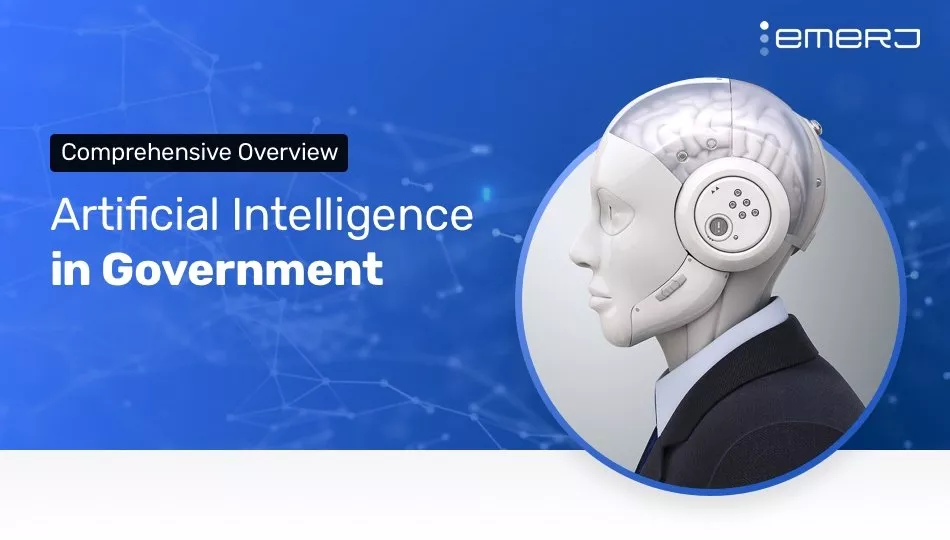
Government interest in AI has picked up in recent years, and many government officials are starting to ask the same questions business executives were asking two or three years ago. Governments and large NGOs are starting to invest in AI, spending budget and time on pilot programs for various AI applications and discussions with people in the field on the future implications of the technology.
Over the summer, our founder spoke at a joint UN-INTERPOL conference in Singapore on the implications of AI for law enforcement. More recently, he spoke at the UN in Geneva on the current applications of AI, completed a speaking tour for the World Bank across Europe and Asia during which he discussed how AI could help improve healthcare in developing nations, and spoke with generals and colonels studying at National Defense University in Washington DC.
As machine learning capabilities improve, world governments will likely invest even more in AI research. IDC estimated the US government’s investment in cognitive and artificial intelligence technologies will grow at a CAGR of 54.3% between 2018-2021. Currently, national and local governments are working with academia and industry leaders to bring to life AI projects that range in application from coordinating traffic to digitizing backlogs of government documents.
We researched the public sector to find out where AI was driving value for governments of all sizes and to get an idea for what government officials are thinking about the technology.
This report covers AI projects that governments have piloted, implemented, or planned across three applications:
- Citizen Engagement
- Improving Operational Efficiency
- AI Strategies for Policy and Legislation
That said, AI applications in government are nascent today. Governments may need to overcome several hurdles to successfully adopt the technology:
- Government leaders might need to invest in upgrading their legacy IT systems. Not doing so risks compatibility issues when it comes time to integrate the software.
- Government leaders should make sure their departments have the necessary computing resources for an AI project. Cloud computing solutions may suffice for certain AI applications, but more heavy data crunching might require more expensive graphical processing units.
- Government leaders should be prepared to hire data scientists and subject matter experts that can collaborate to determine the low hanging fruit problems that AI could solve for a given government department.
Below, we detail some of the current AI projects that governments have worked on. One common theme among these projects seems to be that many governments are engaging in exploratory AI projects through collaborative public-private partnerships with academia and industry.
Citizen Engagement
New York City Department of Social Services
The New York City Department of Social Services (DSS) has a staff of around 18,000 and offers public assistance and employment services to over three million citizens. In one of their initiatives, called the Supplemental Nutrition Assistance Program (SNAP), employees of the government agency needed to process around 70,000 SNAP applications per month.
Citizens wishing to avail the DSS services were largely walking into the government’s brick and mortar service centers to submit their SNAP applications. With such a large number of applications and limited manual resources, DSS decided to digitize and automate the process by offering a self-service online portal called the ACCESS HRA (AHRA).
The ultimate goal of the project was to improve the online experience for website visitors and reduce the number of people entering their brick and mortar service centers. The AHRA portal purportedly allows users inquiring about disability benefits, income support, food assistance, and health insurance to view their case status, account balances, and e-notices.
IBM and DSS engaged in a private-public partnership to develop the portal. The IBM Watson Health Government team was tasked with finding a scalable solution to maximize outreach to the customer base. IBM was allowed to access data from PC banks at 15 of DSS’ physical service centers. This allowed IBM to access user feedback that illuminated trends in what people wished to see from the program.
The partnership established a multidisciplinary team with a mix of public and private sector business and tech experts. The team worked out of the DSS design studio, where elements of the self-service portal were developed jointly.
According to Lauren Aaronson, Assistant Deputy Commissioner for the Office of Business Process Innovation at DSS, after the project with IBM, over 75% of SNAP applications were submitted online, and foot traffic in the physical service centers was reduced by 30%.
The 4-minute video below explains more about how the NYC DSS & IBM Watson Health collaborated to improve access to nutrition assistance:
The NYC DSS was not explicit in how they leveraged IBM Watson’s machine learning capabilities, but Watson is predicated on AI. As a result, we may be able to infer the product’s use. Watson may have allowed the DSS to set up a digital portal with search capabilities built on natural language processing. We detail a use case for this capability in banking in our report on natural language processing in banking.
Additionally, IBM Watson may have allowed NYC DSS to digitize their paper documents using machine vision. In doing so, the DSS would theoretically be able to search their document scans for various keywords related to casework as if they were more structured documents that had been entered digitally to begin with.
US Citizenship and Immigration Services
In 2015, the US Citizenship and Immigration Services (USCIS) announced the launch of a chatbot named Emma. Emma can reportedly answer questions on immigration and take visitors to the right page of the USCIS website. The USCIS was receiving a high volume of customer queries, with over 14 million calls on immigration issues each year.
Users can click the “Ask a Question” and “Need Help? Ask Emma” links in the upper right corner of the USCIS webpage. In cases where Emma cannot find the right information, the software automatically redirects the customer to a human agent.
We could not find any robust case studies reporting success with the chatbot. We can, however, infer that the chatbot uses natural language processing and natural language generation to work. The algorithm behind the chatbot was likely fed thousands of text messages involving various common immigration questions and requests for services, such as requests for the status of one’s visa applications.
These messages would have been labeled by humans as various types of inquiries, such as “request for an application form,” or some other. This would have trained the algorithm to discern the chains of text that make up a message involving one of these types of inquiries when presented with a message that was not labeled. The chatbots would then generate a response to the user.
Infocomm Development Authority of Singapore
The government of Singapore recently announced a partnership with Microsoft to develop conversational interfaces for their Smart Nation Initiative. Vivian Balakrishnan, Minister for Foreign Affairs and head of the Smart Nation Initiative, announced the government’s plans to explore the use of chatbots for selected public services. To this end, the Infocomm Development Authority of Singapore (IDA) is working alongside Microsoft to build conversational intelligence into existing public services as a proof of concept project. The goal for the project is to make online public service websites more accessible and engaging for all citizens.
The IDA had previous experience developing a virtual assistant called “Ask Jamie” that could be implemented on the websites of other governmental agencies to answer questions in specific domains. When users visit the agency website, a chat window automatically opens up, and Jamie can respond to user inquiries by way of natural language generation.
The IDA claims that Ask Jamie can also be trained to ask follow-up questions in case the search query from a user is too broad. If the question is not something for which Jamie could find an answer, the chatbot purportedly transfers the user to a human representative in the government agency.
As for the Smart Nation Initiative, Microsoft aims to complete the proof of concept in three steps:
- The first generation chatbots will aim to search and retrieval of information from existing databases using natural language processing. For example, a user might be able to find the right web page for filing a visa form inside a government agency’s website.
- The second generation chatbots will have added features that enable users to complete simple tasks, such as booking an appointment or making a transaction on a government website. These chatbots might be able to book an appointment with a consulate and allow users to pay any fee involved in the process.
- The third generation chatbots are aimed to be personalized, where users can ask questions and receive highly individualized information. For example, the user might receive information about what documents they might have to submit to the agency based on existing records for that particular user.
According to the press release, Microsoft will also work with the government of Singapore to open a Centre of Excellence (CoE) for Leadership in Digital Transformation for Government and Industry. The CoE will also support the proof of concept with IDA to develop capabilities that can serve multilingual populations and people of varying ages.
Improving Operational Efficiency
Automated Traffic Control
City of Pittsburgh
The City of Pittsburgh collaborated with Rapid Flow Technologies to develop SURTRAC (Scalable Urban Traffic Control), an automated traffic optimization and control software. City traffic control departments can use SURTRAC to manage traffic flows through several intersections and use AI to optimize the traffic systems toward reduced travel times, reduced number of traffic stops, and reduced wait times.
Pittsburgh Department of Transportation worked with Rapid Flow Technologies in 2012 to install the system in a pilot project in the East Liberty neighborhood of Pittsburgh. Surtrac was connected to a network of nine traffic signals in three major roads in Pittsburgh (Penn Circle, Penn Avenue, and Highland Avenue).
Surtrac received data from sensors or cameras embedded in the traffic signals and calculated the traffic allocation projections of the number of cars flowing out at each intersection. The software also re-calculated this projection every 1-2 seconds continuously to make it highly reactive to sudden changes in traffic conditions.
We can infer that this was made possible due to machine vision technology. The machine learning algorithm behind the software was likely fed labeled images of cars at various angles, in various lightnings, going at various speeds, and in various volumes of traffic. This would have trained the algorithm to discern traffic volume when presented with traffic footage that was not labeled.
Rapid Flow claims SURTRAC helped the city reduce travel time by 25%, traffic stops by 30%, wait time by 40%, and overall emissions by 21% during the course of the pilot. Rapid Flow then collaborated with local Pittsburg administration to expand the solution to other parts of the city, bringing the total of SURTRAC-installed traffic signals to around 50.
Greg Barlow is CTo at Rapid Flow Technologies. He holds a PhD in Robotics from Carnegie Mellon University.
Predicting Fire Risk in Buildings
Atlanta Fire Rescue Department
AI researchers from Georgia Institute of Technology, Emory University, and the University of California, Irvine worked with the Atlanta Fire Rescue Department (AFRD) to develop a predictive analytics software aimed at identifying buildings that have a higher likelihood of fire incidents.
The researchers developed Firebird, which purportedly uses historical data for 58 variables made available to them by the AFRD. This includes data such as property location, fire incidence, building size, building structure, and year built for the period 2010–2014. The data was fed to an AI predictive analytics software and the algorithms were tweaked to forecast fire risk scores for 5,000 buildings. According to the university, the software accurately predicted 73% of fire incidents in the building.
In the 2-minute video below, university researches explain how the Firebird software predicts fire risk in Atlanta’s buildings:
AI Strategy for Policy and Legislation
The proliferation of AI in government might warrant the need for a macro level strategy for world governments, simply due to the disruptive potential of AI. Governments need to ensure that their policies and legislations are coherent with how AI might evolve in the next decade. Below we provide snapshots of some of the broader initiatives by world governments detailing their strategies. These initiatives are relatively nascent and robust information on them is limited.
Germany
Germany’s Federal Government announced that it was drafting a Strategy on Artificial Intelligence (AI) that will be presented at the 2018 Digital Summit in Nuremberg in December.
In their press release, the German Federal Government stated they will consult several experts on the application possibility space and regulations that might be needed. These experts were from industry associals and academia all over Germany and their insights will serve as a basis for the development of the strategy. This panel of consultants will also help with defining goals and fields of action for the Strategy which will eventually be adopted by the German Federal Cabinet.
Japan
National Institute of Advanced Industrial Science and Technology (AIST) and METI Ministry of Economy, Trade and Industry have announced a collaboration aimed at attracting top AI researchers for the development and commercialization of Japanese AI technologies. To this end, the Japan Meteorological Agency, Japan Patent Office, Electricity, Traffic and Transport authorities are currently undertaking AI projects which can help augment the capabilities of human operations in tasks such as patent and trademark examination, the management and forecast of traffic, and the development of predictive capabilities for emergency responses
India
In our AI in India research report, we noticed the experts we interviewed seemed to agree that having a formal AI policy in place with a mission statement as to how AI should evolve in the country might be necessary to improve awareness among citizens. In June 2018, the government think-tank, National Institution for Transforming India (NITI) Aayog (Hindi for Policy Commission), presented their National Strategy for Artificial Intelligence. Additionally, Indian government’s Commerce and Industry Department also launched a Task Force on Artificial Intelligence for India’s Economic Transformation in 2017.
There seems to be some evidence that Indian state governments are already applying AI for certain applications such as citizen engagement. For example, The Andhra Pradesh government announced a partnership with Microsoft to develop the Kaizala app. Kaizala is being used to collect citizen feedback from social media and the government’s previously existing web-portals. The customer feedback is automatically sorted and routed to the appropriate department for consideration.







